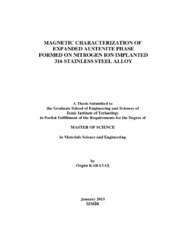Please use this identifier to cite or link to this item:
https://hdl.handle.net/11147/4297| Title: | Magnetic Characterization of Expanded Austenite Phase Formed on Nitrogen Ion Implanted 316 Stainless Steel Alloy | Other Titles: | Azot İyonu İmplante Edilmiş 316 Paslanmaz Çelik Alaşımında Oluşan Genişletilmiş Östenit Fazının Manyetik Karakterizasyonu | Authors: | Karataş, Özgün | Advisors: | Öztürk, Orhan Selamet, Yusuf |
Keywords: | Ion implantation Stainless steel Expanded austenite phase Magnetic force microscopy imaging Ferromagnetic domains |
Publisher: | Izmir Institute of Technology | Source: | Karataş, Ö. (2015). Magnetic characterization of expanded austenite phase formed on nitrogen ion implanted 316 stainless steel alloy. Unpublished master's thesis, İzmir Institute of Technology, İzmir, Turkey | Abstract: | Austenitic stainless steels (SSs) are technologically important alloys and highly resistant to corrosion in a variety of environments. Nevertheless, these materials have a few drawbacks; they are rather soft materials and susceptible to wear. Correspondingly, an improvement of the surface properties is often desirable. Ion beam techniques are widely used to enhance surface properties of these alloys. Surface modification of austenitic SSs by nitrogen ion beams at moderate substrate temperatures near 400 ºC, leads to the formation of a high N content phase. This phase, known as an expanded austenite phase, γN, creates a hard and wear resistant layer on the stainless steel. Additional property of this phase is related to its magnetic structure due to the large amount of nitrogen insertion and corresponding lattice expansion. In the current study, new data corresponding to structural and magnetic nature of the expanded austenite layers on austenitic 316 SS by low-energy, high-flux nitrogen ion implantation are presented. Phase and compositional analyses, surface topography and magnetic features of the nitrogen ion implanted layers were studied by a combination of experimental techniques involving XRD, SEM, AFM, MFM, VSM and MOKE. Nitrogen implantations were performed for 30, 90 and 240 minutes of processing time, at a fixed temperature near 400 °C. Relatively low-energy (0.7 keV) and high-flux (2 mA/cm2) ion beam conditions were carried out during the implantation. Combination of the aforementioned techniques provides strong evidence for the formation of the γN phase with mainly ferromagnetic characteristics. MFM imaging reveals stripe-like domain structures of the nitrogen ion implanted layers. Both VSM and MOKE analyses display hysteresis loops of the layers. Ferromagnetism in the γN layers are manifested by MFM, M and MOKE analyses. Ferromagnetic structure is linked to large lattice expansions 0 due to high nitrogen contents at. . s an interstitial impurity, nitrogen dilates fcc lattice of 316 SS i.e. Fe-Fe distance is increased, which strongly influences the magnetic interactions. | Description: | Thesis (Master)--Izmir Institute of Technology, Materials Science and Engineering, Izmir, 2015 Includes bibliographical references (leaves: 50-52) Text in English; Abstract: Turkish and English Full text release delayed at author's request until 2015.08.16 |
URI: | http://hdl.handle.net/11147/4297 |
| Appears in Collections: | Master Degree / Yüksek Lisans Tezleri |
Files in This Item:
| File | Description | Size | Format | |
|---|---|---|---|---|
| T001334.pdf | MasterThesis | 2.64 MB | Adobe PDF |  View/Open |
CORE Recommender
Page view(s)
322
checked on Apr 28, 2025
Download(s)
124
checked on Apr 28, 2025
Google ScholarTM
Check
Items in GCRIS Repository are protected by copyright, with all rights reserved, unless otherwise indicated.